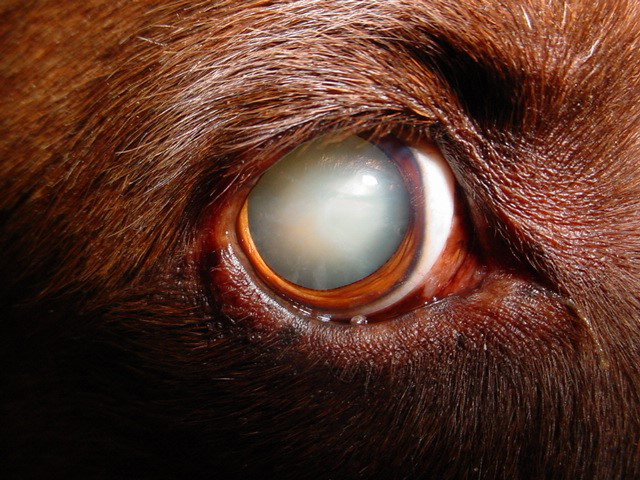
Clearing up canine cataracts
Monday, February 3, 2020
Cataracts are a leading cause of blindness in people around the world and the most common cause of vision impairment in people over age 55. Similar to people, as dogs age, their eyes may start to look cloudier. While many similarities between the human eye and the canine eye exist, there are many differences, including the most common cause of cataracts in dogs.
A cataract is an opacity in the lens, which focuses light on the retina. In dogs, the most common cause for a cataract is genetics. Most dogs who develop inherited cataracts do so when they are young to middle-aged. Breeding a dog with inherited cataracts can lead to passing this mutation to their offspring. An annual ophthalmic exam is recommended for any dog that will be used for breeding.
Diabetes is the second most common cause of canine cataracts. Within a year of being diagnosed with diabetes, most dogs will develop advanced cataracts. Interestingly, it is very uncommon for cats with diabetes to develop cataracts due to varying concentrations between species of enzymes that process high levels of sugar in the lens.
Surgery is required to remove cataracts and restore vision. Generally, cataract surgery is recommended for patients with advanced cataracts or cataracts that impair vision. Cataract surgery in dogs is performed similarly to that in people except that dogs must be completely anesthetized.
Cataract surgery is an elective procedure. If surgery cannot be performed, visually impaired dogs can still have a wonderful quality of life. To adjust to vision loss, dogs rely very heavily on their senses of smell, touch and hearing. They can make minimal adjustments to make sure they cannot inadvertently injure themselves, such as avoiding stairs, pools, etc. Advanced cataracts can lead to inflammation inside the eye so dogs with cataracts should be treated with anti-inflammatory eye drops.
While some older dogs do develop cataracts, nuclear sclerosis is the most common reason for dogs to develop a cloudy appearance to their eyes. A normal aging change in dogs, nuclear sclerosis does not cause loss of vision. The compression of lens fibers and hardening of the center of the lens results in a cloudy appearance. This change also occurs in people resulting in presbyopia. This is the reason that people around the age of 40 commonly need reading glasses since their lens is no longer as “flexible” as it once was. If dogs read the newspaper, once they reached about 8 years of age, they would need readers, too!
It has been said that the “eyes are the window to the soul.” If you are worried that your dog’s eye appears cloudy, consult your veterinarian for an ophthalmic exam to determine the cause and refer you to a veterinary ophthalmologist if needed. Oklahoma State University College of Veterinary Medicine’s ophthalmology team offers cataract consultation appointments and surgery.
STORY BY: Emily Sharpe McCool, DVM, MS, DACVO, an assistant professor of ophthalmology in the Department of Veterinary Clinical Sciences and a diplomate of the American College of Veterinary Ophthalmologists at Oklahoma State University College of Veterinary Medicine.
